|
FAQs about Galatheoids
called Porcelain/Anemone Crabs, Family
Porcellanidae
Related Articles: Squat Lobsters, Hermit
Crabs, Crabs
Related FAQs: Hermit Crabs
1, Micro-Crustaceans,
Amphipods, Copepods, Mysids, Hermit
Crabs, Shrimps,
Cleaner
Shrimps, Banded Coral
Shrimp, Mantis
Shrimp, Anemone
Eating Shrimp,
|
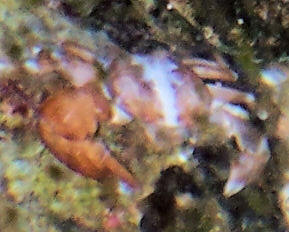
|
Bubble tip and anemone crab compatibility 2/28/16
I had a Sebae anemone which had an anemone crab associated with it which were
separated due to some issues with chemical war fare going on in my 220. The
Sebae is improving in separate quarters and the bubble tips that
remain are clones and one has been unhappy since the anemone crab took up
residence. At first I thought maybe the continuance of chemical ware fare was
the reason one of the bubble tips was not looking healthy but the sister to it
is fine and inches away. It occurred to me that since that has been going on it
is about how long the anemone crab has taken up residence so can they be an
irritant to a bubble tip and cause this?
<Yes; can be>
It look better at night than daytime but it has been secluded in the shadows out
of the light for about 2 weeks now. I run a lighted sump with lots of macro
algae 24/7 and the only thing shut down at night are the tank lights and Tunze
wave box. I run a canister filter with carbon. Was running 24/7 but my stony
corals seemed to not be as active at night so I only run it in the day during
feeding cycle.
Thanks in advance.
Mike Murphy
<I would leave all as is for a few more weeks; in the hope that the Entacmaea
and crab will become accustomed to one another. Bob Fenner>
Re: Bubble tip and anemone crab compatibility 2/28/16
Never occurred to me that the problem I described with the Sebae Anemone may
have been caused by the crab also as that was his residence prior to the
bubble which now is posing the same symptoms but almost immediately within days
of hosting. I may not have chemical war fare after all
<Possibly. B>
New additions... Crusty Menagerie 3/19/11
I have a 120gal reef tank with multiple residents. I have 3 emerald
crabs, a reef lobster and a fire and coral banded shrimp. Do you think
I can add a porcelain crab or 2 to the tank. I just love the look they
have.
Thanks
Tom
<Umm, you may well have problems with the compatibility of the
current crustaceans... reef lobsters are quite predaceous... the
Stenopid only a smaller version/bit less... and the Mithraculus w/
growth/size, opportunistic omnivores like most all Decapods. Do
see/read on WWM re all these... the Anomuran I would leave out unless
you have a well-established symbiont for it/them to hide out in (stay
out of the claws of the others).
Bob Fenner>
Anemone crab, incomp. 3/18/11
Hi everyone
Hoping you can help, about a month ago I bought two anemone crabs
<What/which species are these? Neopetrolisthes?>
and a mini maxi anemone,
<Stichodactyla tapetum I take it>
they both hung around the anemone until about a week ago, when one
decided to live instead in one of my Rics.
<The anemone was likely "too sticky">
This was fine, until two days ago, when I came back for lunch, to find
this crab had lost both large claws and one leg! which were at the
front of the tank in the sand, then today found he had lost another
leg! He is still eating with my help. What could have caused this?
<Mmm, a few possibilities... "the other crab" most likely,
or other tankmate... But a reaction from the host/s, a dearth of
biomineral, out of balance alkalinity, a host of mis-supplementing
issues, lack of iodide-ate...>
my tank has been running for nearly a year now, and since the beginning
have heard clicking (can be once or up to three times in a row)
Mantis???
<Maybe>
Stock wise - I have two hermit crabs, three sexy shrimps, two cleaner
shrimps, one pom pom crab and the two anemone crabs, they have all
molted regularly with no problems.
<Then not likely a system issue>
Fish -three Chromis, two clowns, one Banggai and one Tailspot
blenny.
I know I have also go a nasty looking black crab with big claws and
brown stripped legs,
<Oh! This could be the culprit>
have tried to get it out, but so far failed (tried glass, coke bottle
and baited line) Could this have attacked the crab or could it be a
mantis in the tank?
<Either>
I have never seen a mantis in there and watch regularly at night with a
red torch, nothing!
<I'd bait/trap out the unwanted decapods>
The other thing I have noticed are my Chromis which I have had since
November last year, are now hiding at the back behind the rock, only
come to the front for food, where they used to always be at the front
swimming about, another indicator of a predator?
<I do agree with you>
I am thinking about stripping the tank down, but the clicking and the
black crab are both in the very bottom rock, and I would need to take
all out to get at it, and because of this I am very hesitate to do so,
in case I cause a new cycle in the tank and loose all the
inhabitants.
Please can you advise?
<Do read here: http://wetwebmedia.com/swcrabcompfaq3.htm
and the linked files above in this series... till you're aware of
your possibilities>
Thank you for all your help
Wonderful site very helpful, keep up the good work!
Benita Pullen
<Thank you, will do. Bob Fenner>
Porcelain Crab And Sinularia? comp. 11/4/10
To the great folks at WWM,
<Hello Phil>
First time e-mailing a question. I have a 29g BioCube with 3g hang-on
refugium a pair of Firefish, a pair of Yasha Gobies and Pistol Shrimp
with some button polyps and a centerpiece of Sinularia sp. I was
considering purchasing a pair of porcelain anemone crabs
(Neopetrolisthes ohshimai) but was concerned with compatibility.
I've read that they are peaceful crabs and that they can thrive
even without a host anemone. My question is, do you think the crabs
will be likely to attempt hosting in the Sinularia spp.
and if so are they likely to be detrimental to the coral?
<The Anemone Crab or Anemone Porcelain Crabs are most always
associated with anemones in the wild and feed on meaty bits of seafood
and mucus from the anemone.
They will live among live rock if no anemone is present, and are
relatively hardy provided you ensure they are getting enough food.
It is unlikely that they would host the Sinularia, and if they did,
they would likely irritate the coral.
If larger crabs are present in your system, the Porcelain Crab may fall
prey to them. They are aggressive to other similarly sized crabs
including the popular Blue Leg Hermit Crab.>
I love my simple little system and don't want to make any of my
critters upset.
Thank you in advance!
<You're welcome. James (Salty Dog)>
Sincerely
Phil J.
|
Hitchhiker (Xeniid) crab ID 8/11/10
Hello there!
<Howdy>
I found this tiny hitchhiker crawling out from one of the stem of
my newly acquired Xenia colony!
It seems to be called Xenia crab but I could not find any further
information about it other than a few pictures from the web (and
on your wonderful site).
I was hoping you could help ID this crab for me?
Many thanks!
Jason
<Have seen this in the wild... believe it's a
Lissocarcinus species...
search this with the term Xenia commensal. Am putting in
LynnZ's in-folder as well. Bob Fenner>
Hitchhiker Crab ID: Porcellanid Xenia Crab --
8/11/10
Hello there!
<Hello Jason, Lynn here this afternoon!>
I found this tiny hitchhiker crawling out from one of the stem of
my newly acquired Xenia colony!
<It's a pretty little thing isn't it!>
It seems to be called Xenia crab
<Yep. There are photos of them all over the web, in various
BB's, and within WWM.>
..but I could not find any further information about it other
than a few pictures from the web (and on your wonderful site). I
was hoping you could help ID this crab for me?
<Hmmm, well I can tell you that it's not a true crab
(Brachyuran), but instead a false crab (Anomuran -- hermits, mole
crabs, squat lobsters, etc.). More specifically, it's a
Porcellanid (Porcelain crab) of some sort. If you take a good
close look at the photos, you can see that the last (almost
transparent -- very hard to discern) pair of legs is folded up
and held against the body. Of note is that although these legs
are mobile, they're not used for routine locomotion. Instead,
they're apparently used mainly for grooming. True crabs, by
comparison, use that last pair of legs for walking, burrowing, or
in some cases, swimming. Now, as to species, unfortunately, I
can't tell you with any certainty exactly what you have. I
can tell you that I found a photo of what appears to be a color
variant of the same crab in Poppe Images, and they ID it as
Porcellanella triloba: http://www.poppe-images.com/?t=17&photoid=909792
. It has the same dome-like carapace and serrations on the outer
edge, the same gracile, slightly curved claws, same claw arm
proportions, and the same general color pattern. What's
important to note is that the two also share a rather
flattened/straight area between the eyes. There are no apparent
projections of the carapace. The problem I have with this ID is
that every other individual that I've seen with the same
species name, has a distinct series of 3 projections between the
eyes. You can see them at this link (note species name): http://www.poppe-images.com/?t=17&photoid=942351
That's completely different than what we see in the first
photo. Am I saying they got the ID wrong? It occurred to me, yes,
but for all I know, the crab in the first photo could be a
juvenile; who knows? I'm not exactly the authority on crabs.
Given the choice, I'd go with their judgment over mine. Now,
as far as more information on these guys, I can tell you that
they're mostly nocturnal and are usually found in pairs so
bear that in mind if you decide on removal. As far as whether to
keep it/them, it's up to you. The general consensus seems to
be that they're better kept within a large Xenia colony than
a small one, mainly because any potential predation has less
overall impact and is less noticeable. Unfortunately, I can't
tell you one way or the other whether your crab will devastate
your colony or simply take a nip here and there but otherwise be
fairly innocuous. If it were me, I'd leave the little crab as
is, but keep a sharp eye on the Xenia. At the first sign of
trouble, I'd remove the crab and place it elsewhere. Please
see the following link for more photos of the crab similar to
yours (also see Porcellanella picta) and other examples of
Porcellanids on subsequent pages:
http://www.poppe-images.com/?t=11&family=porcellanidae&p=1
>
Many thanks!
<You're welcome!
Jason
<Take care, Lynn Z>
|
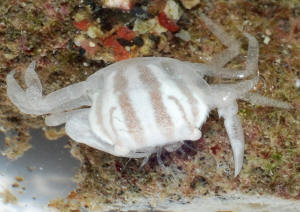 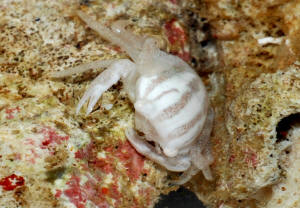 |
|
Another 'Crab ID': Must Be Porcelain Crab
Season! 3/2/10
Hello WWM Crew!!!!
<Hello Sandra, Lynn here with you today!>
This little guy fell out of a piece of live rock I was moving out
of my fish only tank.
<Wheee!>
I'm going to put him in my refugium as I know there are no
truly reef safe crabs except for the commensal crabs in SPS
corals.
<They're one of the safer groups anyway. They're
generally small and stay within/around their particular coral,
feeding on coral mucus, a bit of tissue and whatever else they
can find.>
I have several of those and wouldn't dream of removing
one.
<Good, I'd leave and enjoy them.>
He appears to be a filter feeder maybe in the Porcelain Crab
family,
<You hit the nail on the head. It's a classic Porcellanid
(family Porcellanidae) showing the distinctive 3 pairs of walking
legs, two large claws and long antennae just behind the eyes. If
you look closely, towards the back of the carapace on either side
you'll see another small pair of legs folded up and held
against the body. These are used for grooming. Up front, you can
see the large mouth parts that open up into the distinctive
fan-like structures used to filter organic particulate matter and
plankton from the water column. All in all, it's a neat
little crab.>
..but, of course, I couldn't find a picture that looks
exactly like this guy.
<That's understandable. There are many, many, crab species
out there. Knowing where the crab originated would help, but even
then, it can be a considerable challenge. Sometimes you get lucky
with a very common, well-known species, but most of the time
narrowing the ID to family level is about as good as it
gets.>
I have 2 in my 300 gallon SPS tank that don't appear to be
bothering anything in their vicinity so I wanted to ask while I
happened to have this one out what kind he is
<Unfortunately, a Porcellanid is about as far as I can take
this ID without having the little crab in front of me to see all
the pertinent/distinguishing details.>
..and could get a decent picture of him. If I need to get out the
trap then I will.
<Well, if you want to keep that particular tank a fish-only,
I'd move the crab to the 300g display. Porcellanids are
generally small and don't have much negative impact on a reef
system. They do scavenge as well as filter feed though, so
I'd recommend offering it the occasional pellet food or meaty
bits (of marine origin). Sometimes these crabs aren't able to
obtain enough food from filter-feeding alone.>
The pictures don't show the color as well as I would have
liked but he does have some red and blue accents.
<Yes, they show up fairly well after enlarging the photos.
It's actually a very pretty little crab.>
I didn't know I even had this one until I took the rock out
of the water and he fell out. The ones in my 300 I've only
seen at night and they are actively moving their antennae and
look like they are filter feeding.
<Typical behavior>
I haven't seen them picking anything off the rocks. I have 6
separate refugiums I could put him in. 3 with a DSB, rubble and
Chaeto. 2 with larger and smaller pieces of rubble and Chaeto.
And 1 with just rubble and Chaeto. Which refugium should I put
him in to give him the best environment? I want him to have the
right home.
<Hmmm, I'd either put him in the 300g display as mentioned
above, or put him in one of the fuges with a DSB. You might want
to add a couple of larger rubble pieces though so he'll have
a place to hide. Crabs and other crustaceans like to hole-up in a
secure spot when they molt as they're particularly vulnerable
until their shell hardens. One other issue with the fuge relates
to the Chaeto. Just make sure there's enough room at the
bottom for the crab to crawl around. I've seen Chaeto take
off to the point where it's packed top to bottom. For more
information on Porcelain crabs, please see WWM, starting with the
FAQ's at this link:
http://www.wetwebmedia.com/SWCrabIDF15.htm >
Thank you all so much for the volumes of information and advice
over the years.
<On behalf of Bob and the crew, you're very
welcome.>
The changes you have made to the site to make information easier
to find in the last year is awesome. Maybe 1 day you could add an
image search feature similar to Google image search so you could
scan through "hitchhiker crabs" images and click on the
picture to go directly to the referenced page. That would be
really, REALLY awesome.
<That's a great idea!>
Thank you,
<You're very welcome.>
Sandra
<Take care, LynnZ>
|
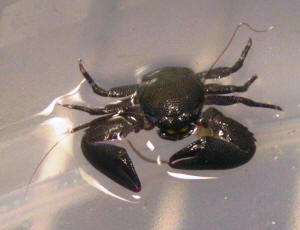 |
Crab Identification: Porcellanid -- 2/23/10
Hello WWM crew,
<Hello Adam, Lynn here today.>
I have a question about a crab I recently found in my reef tank.
<Fire away>
I noticed someone else asking about what I think may be a similar crab
on 1/24/10. That post noted Porcellanid but I have searched and not
found anything that resembles this crab.
<Unfortunately, you may not be able to. There are many species, not
all of which are available as photos on the web or within readily
available books. Beyond that, there are species that haven't yet
been formally described. For example, your little fellow could be
locally known as 'Bob's crab' in some corner of the
tropics, but until it's studied, described, and presented to the
rest of the world, the chances of us running across any
information/photos range somewhere between slim and none. It's
frustrating, I know, but for our purposes, it's often enough to
know which family the crab in question belongs within.>
Unfortunately I do not have a picture as it is the smallest crab I
personally have ever seen. Perhaps 1/2 cm across.
<It could be a juvenile or simply one of the smaller species.
Typically, these crabs are fairly small, with carapaces no larger than
1/2" across.>
It is a tan color but instead of claws it has 2 filter fans.
<Yep, you've got a Porcelain crab, aka a "false" crab
("Anomuran") in the family Porcellanidae. These crabs have 3
pairs of walking legs (as opposed to 4 in
"true"/"Brachyuran" crabs), two claws (usually
large, used mostly for territorial disputes but can be quickly shed
when crab feels threatened), one significantly smaller pair of legs
used for grooming that are held up against the abdomen or posterior end
of carapace, two long antennae just behind the eyes, and two specially
adapted fan-shaped mouthparts used to filter organic particles/plankton
out of the water. As for the missing claws in your individual, they
could have been dropped due to a perceived threat/stress, or lost due
to injury/predation.>
They look just like feather dusters but are clear. It sits in the same
spot all the time and I only see it at night with the flashlight. It
just sits there and filters away with these fans. Opening and closing
them in the current.
<Terrific observations! This behavior is typical of Porcellanids.
Thankfully, they're filter feeders and scavengers that don't
normally pose too much risk in a mixed reef system. I would offer it
the occasional sinking pellet or meaty bit (of marine origin) such as
shrimp, clam, silverside, or Mysis to supplement its diet. Unless you
have a fully mature reef system, the crab may not be able to acquire
sufficient food from the water column alone. For more information,
please use our Google search engine and the terms Porcellanid or
Porcelain crab: http://www.wetwebmedia.com/Googlesearch.htm >
Any insight would be greatly appreciated!
<Hopefully the above information/Google search results will help. If
not, please don't hesitate to contact me/us. In the meantime, enjoy
your little Porcelain crab!>
Adam Thompson
<Take care, LynnZ>
Sexy shrimp, porcelain crab, Perc clowns, and rbta
compatibility? 2/11/10
Hi,
I have a large BioCube
<An oxymoron... jumbo shrimp, military intelligence...>
currently with a RBTA and 2 juvenile (est. 6-8 months old) onyx Percs
hosting in it, running on DIY LEDs.
The BioCube has SteveT's fishguard installed, and plastic mesh
(sewing grid guide for yarn projects, as per Karen's Rose Anemones
site) tied completely around the powerhead intakes, as part of my
efforts to anemone- and fish-proof the tank.
<Good>
I'd like to introduce sexy shrimps and/or porcelain crabs to this
system.
<Okay>
I did some quick Googling and reading WWM FAQs and noted from some
forum posts that porcelain crabs may attempt to boot my clowns out of
the rbta, which is why I'm considering adding another (r)bta.
<Mmm, I wouldn't do this... unless they're genetic clones,
there's too much chance of trouble twixt>
I'd probably get one from a fellow area reefer whose rbtas
regularly clone themselves (in fact my current one is from him,
it's healthy, feeding, and very colorful, etc.).
<Oh!>
Is there any compatibility information on sexy shrimp, porcelain crabs,
and clowns in a tank with a limited number of host anemone?
<I can/will only offer my personal observations here. Have seen
Porcellanids and Clowns together in Carpet Anemone species in the
wild... and Sexy Shrimp in Anemones that had or lacked Amphiprionines,
but have not
"run" (or swam) into a situation where all three were
resident in one such Actinarian species, and have never seen two of
them in an Entacmaea. I don't know, but don't think this will
work. Bob Fenner>
Thanks,
Alex
|
ID Crab: Porcellanid -- 1/27/10
Hi Crew,
<Hello there, Lynn here this evening.>
Is this a porcelain crab?
<It certainly is. It appears to be Petrolisthes galathinus, or
at least one of the species within this complex. Common names
include the Purple Porcelain crab and Banded Porcelain crab
(family: Porcellanidae). They're primarily filter feeders,
but will scavenge as well. Bob has also noted that they're
not to be trusted around other invertebrates so beware if you
have any. See this link re:
http://www.wetwebmedia.com/galatheids.htm >
I don't keep crabs not even hermits because I have a small
tank with small fish.
<That's understandable. Fortunately, these shy, mostly
nocturnal crabs stay fairly small (carapace width to ~1/2").
Those big claws are mainly for territorial squabbles and are
sometimes shed if/when the animal feels threatened. See this link
for a photo of P. galathinus feeding.
http://www.animal-image.com/CoralReef/Crabs/Banded%20Porcelain%20Crab/slides/BandedPorcelainCrab_PetrolisthesGalathinusTRCr_Ap8R.php
>
Got this by mistake in an order. Keep it or not?
<It's up to you. While these crabs pose less threat than
say, a big Xanthid, they're still scavengers. I just
can't tell you for certain that it won't go after
sleeping fishes if it gets hungry enough or the opportunity
presents itself. One way to lessen those chances further is to
keep the crab well fed with meaty bits (of marine origin),
sinking pellets, etc. Honestly, I think it's a neat little
crab. As long as I didn't have a tank full of tiny fishes
(gobies and the like) I'd be tempted to give it a chance.
Take care and good luck, LynnZ>
|
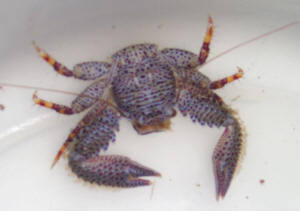 |
|
Mystery Crab: Likely Anomuran: Porcelain Crab --
10/17/09
Hi
<Hello Jan, Lynn here this morning.>
I have a new Red Sea Max 1250 tank set up just with live rock for
the moment and have 3 crabs? These have a large claw, small order
pincer thing and banded legs but the body is tiny, much smaller
than the big claw. They seem to feed by two feeler things which
go up and down to the mouth in sequence and these have two large
fans attached. Look a bit like a Spanish dancing girl!
<Heee! Very observant! What you describe is typical of
Porcelain crabs (family Porcellanidae). Those 'fans' are
used to filter organics/plankton from the water. For more
information on these neat little 'false' crabs, please
see the FAQ titled 'Mystery Crab (actually an Anomuran) --
Likely Porcelain Crab -- 8/16/09' at the following link:
http://www.wetwebmedia.com/squatlobfaqs.htm >
Any idea what they are and if dangerous,
<Luckily, they're not dangerous to humans (beyond the
possibility of getting pinched), but like most crabs, they're
opportunistic critters so do keep them well fed as noted at above
link.>
I have not yet put anything in the tank just cleaning crew snails
and a blued legged hermit.
<Oh, you're just getting started! Enjoy the process and
all the critters that show up, including these neat little
guys!>
Many thanks.
<You're very welcome, it was my pleasure.>
Jan Randall
<Take care, Lynn Zurik> Re: Mystery Crab: Likely
Anomuran: Porcelain Crab -- 10/17/09
Hi Lynn
<Hi Jan!>
Many thanks for the fast reply.
<All due to your terrific description!>
I think the animal is an Anomuran although mine don't look
like any picture so far, so is probably Anomuran randalli!
<Heeee! There are many genera and species in the family
Porcellanidae so identification to species level can be a real
challenge. If you can get together some good photos though, and
tell me where the crabs/rock originated, I'd be glad to give
it a try. I may not get it to species level but I might be able
to narrow it to genus. Even that can be an accomplishment! If you
do get a chance to take some photos, try to get a good one from
above showing the carapace, all the legs, and the claw arms.
Also, if you can get a good close-up of both claws/arms, that
would be terrific. The more detail you can capture, the better
chance we have of success! Oh, and one last thing, if you remove
the crab to a bowl of tank water to take photos (keep crab
submerged), don't be too surprised if the little fellow loses
a claw or two. These guys sometimes drop them when feeling
threatened/stressed, but with good health/husbandry, they should
be back within a few molts.>
Great to know I can ask the experts when I get stuck.
<Heeee! I'm no expert, but I'm happy to help
anyway!>
Best wishes, Jan.
<Same to you, Jan. Take care, LynnZ>
Re: Mystery Crab: Likely Anomuran: Porcelain Crab --
10/18/09
<Hi Jan>
Right, will have a go when I can.
<Sounds great. I look forward to seeing the little
fellows!>
Best wishes, Jan.
<Thanks, Jan. Take care, LynnZ>
|
| Me too. |
|
Mystery Crab (actually an Anomuran) -- Likely
Porcelain Crab -- 8/16/09
Hi.
<Hi Sarah, Lynn here today.>
I hope you can help me identify this little guy.
<Me too!>
I've had my tank up and running a year and a half now. The
last time I bought any new critters for my tank was about 3
months ago.
<Okay>
This morning, this little guy showed up.
<Neat! It looks like a little porcelain crab, family
Porcellanidae, of which there are many genera and species.
They're primarily filter feeders that rhythmically wave a
pair of interesting feather/fan-like mouth parts through the
water in order to gather organics, plankton, etc. Although these
are referred to as crabs, they're not actually 'true'
crabs (Brachyurans). They are instead Anomurans, a group that
includes hermits, mole crabs, squat lobsters, etc. Both
Brachyurans and Anomurans are decapods (ten-footed) crustaceans,
however, crabs such as yours have 3 pairs of walking legs instead
of 4. A much smaller fourth pair is folded and held either above
or below the abdomen (not used for walking). They also have long
antennae just distal to/behind the eyes, a mobile abdomen that
can be used to propel the crab, and large claws that are used for
territorial disputes and defense instead of feeding/predation.
These crabs, although primarily filter feeders, are also
opportunistic scavengers and detritivores. Luckily, they're
generally small and don't pose anywhere near the risk that
true crabs do (such as Xanthids -- family Xanthidae). I would
keep this little fellow around and enjoy! As a scavenger,
it'll likely take most foods -- pellet, flake, bits of meaty
foods (of marine origin). For more information, please see the
following links: http://www.wetwebmedia.com/galatheids.htm
Similar species, listed under 'A new Porcellanid species from
the Caribbean Sea': http://www.uni-giessen.de/porcellanidae/
>
Thanks again,
<It was a pleasure.>
Sarah
<Take care, LynnZ>
|
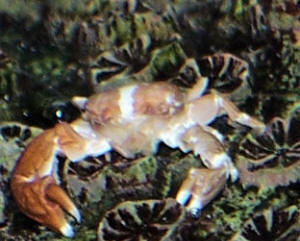  |
|
Pls forgive me 6/30/09
Lynn... have placed yet another very generic "whatizit"
invert. query in your in-folder...
BobF
Hi Bob!
Heheee! No worries, I'm working on it right now. One looks
like a sea spider...the other crab(s) I can't quite tell.
Right now I'm manipulating the photos every way I can think
of trying to determine whether there are 3 walking legs on each
side or four and whether there are antennae just distal to the
eyes. It's not going too well so I'm about to call it a
day - or at least a crab!
Take care,
-Lynn
<Mmmm, yumm, I wish we were having spicy crabs in Bali right
now... Oh, the mess! Worse than any/all Olde Bay incidents!
BobF>
<<Heeee - now that's something! Just eating blue crabs
with all the Olde Bay seasonings, etc on them is a gigantic mess
- I can't imagine trying to eat crab covered with a thick
spicy sauce! What a mess indeed, but I bet it's well worth
it! -Lynn>>
<Oh yesssss! Then you can eat the juice et al. as a sort of
soup/compote at the end! BobF>
Re: Aiptasia? Now, ID's: Sea Spiders and Crabs --
6/30/09
Hi Bob,
<Hi Peter, Lynn here today>
Thanks for the help ID'ing those.
<On behalf of Bob, you're very welcome!>
Since my peppermint shrimp isn't going for them, I may try
some Joe's Juice or something of that sort.
<Aiptasia-X reportedly works well along with the standard
Kalk/water method (Google for more info at WWM:
http://www.wetwebmedia.com/Googlesearch.htm).>
Wondering if you could help me out with ID'ing these things
and crabs from my new 46 gallon tank.
<I'll sure try.>
The tank is about three months old and I have some new hitchers I
haven't seen before. There are some tiny spider-like animals.
I have at least three of these. They are about 1/4 inch across.
Not sure if they are small arrow crabs?
<I don't think so. I can't quite see the body, but
overall they look more like Pycnogonids/sea spiders to me
(carnivorous marine arthropods). Please see the following links
for more information: http://www.wetwebmedia.com/pycnogonids.htm
http://www.wetwebmedia.com/seaspiderfaqs.htm
http://en.wikipedia.org/wiki/Sea_spider
>
There are also some larger crabs, at least three, all with the
same coloration. The largest of these is an inch across.
<Gotcha. Unfortunately, I can't quite see enough detail to
ID but with your help I think we can narrow down the field of
possibilities. First of all, do the crabs have 3 walking legs on
each side or four (not including claws)? Also, do you see any
long antennae just behind the eyes (they may be fairly clear so
look closely)? Those two factors alone can help us determine how
safe these crabs will likely be around your fish. Generally
speaking, if it looks like a crab but has three pairs of walking
legs + long antennae positioned behind the eyes, it's a
false/'porcelain' crab (Family Porcellanidae). These are
primarily filter feeders but they also scavenge. The good news is
that they don't pose nearly the risk to fishes that true
crabs do. True crabs have four pairs of legs (most adapted for
walking, some species' for swimming) and fairly short
antennae placed in front of (between) the eyes. These are
opportunistic creatures that will, if given the chance, make a
nice meal of any fish, fellow crustaceans, etc. This risk
increases with size, competition/lack of sufficient food, and
ease of access (especially small bottom dwelling or sleeping
fish, crustaceans in molt, other benthic invert's). For more
information on porcelain crabs and true crabs, please see the
following links (as well as associated links at the top of each
page):
http://www.wetwebmedia.com/marine/inverts/arthropoda/crabs/swcrabs.htm
http://www.wetwebmedia.com/galatheids.htm
>
I guess I was wondering if they will be hazardous to my 1-inch
ring-eyed goby or yellow clown goby. There are the only fish in
there so far.
<See above. If those crabs have 4 legs on either side, I'd
get them out and find them a new home. Small Gobies and crabs are
not a good combo!>
Thanks again for the previous early response!
<Again, on behalf of Bob, you're most welcome!>
Peter
<Take care, LynnZ>
|
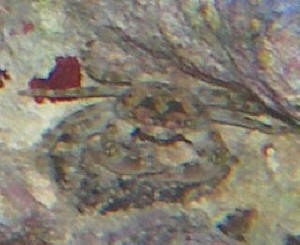
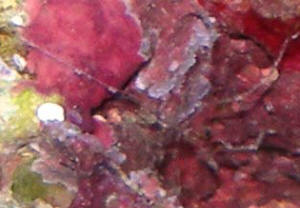 |
Porcelain Crab vs. Mantis Shrimp. No Contest 11/23/06 Hi crew
<Hi Kerryn> I've found your site very helpful with a lot of
my questions on marine tanks, just a new comer to the marine world now
having my tank running for a year, have made all the mistakes but
I've learned by them as well, but one problem I can't solve is
a with an anemone porcelain crab, I have searched the net for hours
trying to find the answer. I have two anemone porcelain crabs that live
very happy in an anemone each, one had a green algae forming on the top
of its body, I thought this was a normal process maybe the crabs shell
was getting old and was ready to shed, but obviously not, I woke up
this morning to find him on his back in the middle of the tank, I did
find some information about a disease that forms on a porcelain crab
but didn't mention what it looked like? I do have a mantis shrimp
cutting about in the tank, I can see a nip out of the crabs claw its
black around the wound, I don't know how long the wound has been
there, it's known that they will shed a claw or leg if threatened,
everything is running brilliant in the tank, temp is 24 to 25 degrees,
would really like to know what happened to it I've only had them
two and half months-ish. <I'm surprised they lasted that long
with that "Hit Man" you have in the tank with them. Mantis
Shrimp belong by themselves and will kill, dismember, and eat crabs,
shrimp, etc. along with smaller fish that it can sneak up on during the
night. He is going to have to go or the other crab or a fish will be
next.> Cheers <And to you, James (Salty Dog)> Kerryn.
Funny Trigger Story - 09/23/06 I just moved my three-inch
male Blue Throat Trigger from quarantine to the display tank 24 hours
ago, and he has remained hidden in a nook in the rockwork of my 90
gallon tank ever since. <<Not unusual...can be rather shy/timid
as triggers go>> I'm not worried about him. He acted the same
way in quarantine for the first three or four days only to come out and
be friendly for the following month. <<Indeed>> I have two
RBTA (a recent split), a B/W Ocellaris Clown pair, a Twin-spot Hogfish
and a small Wheeler's shrimp goby that hasn't found his pistol
shrimp yet. I have probably twenty snails, two large cleaner shrimp,
one hermit crab and one small porcelain crab that came with some live
rock, all running well and getting along for the past seven or eight
months. <<Excellent>> Anyway, the trigger has taken up
residence in the same cave as the porcelain crab. <<The porcelain
crab hasn't taken up residence in one of the anemones?>> Now
here is the odd thing. The crab, which can't even be an inch long,
seems to be trying to bully the trigger out of its hiding spot.
<<Amazing creatures we keep, eh!>> They seem to have come
to an arrangement and aren't bothering each other at the moment.
<<Ah, yes...and will likely cohabitate just fine>> I just
thought y'all would like to hear about a tiny crab picking on a
trigger that is probably twenty times his size. Thanks y'all for
the wonderful work you do. My fish and I owe you for all of your great
advice. Jonathan <<Were pleased to be of service...and thank you
for sharing. EricR>>
Porcelain Crab Concerns 8/22/06 Hello All, <Hi there>
You guys get a lot of question from folks that have real problems, and
you provide excellent, thorough answers. My question will seem rather
silly. But, I have a need to know. I have a white Porcelain crab with
brown spots. I recently purchased a BTA in which my crab has taken up
residency. Totally expected. What I didn't expect is for my pretty
crab to turn all brown and yuck. Is this normal? Thanks, Jacqueline
<Not unusual... may well change back over time. The adjustment of
these Squat Lobsters to new hosts can result in such changes. Bob
Fenner>
Peppermint shrimp and porcelain crabs... and Mantis and Clowns
7/18/06 Hi.. <Hello there> I have a 55 gallon display tank
that is being left fallow while my fish reside in a QT tank. I am well
aware of the dangers that mantis shrimps pose, and I know that one
lived in my tank because I often saw him and he killed my coral banded
shrimps. Now, I have not seen the mantis shrimp for over a month and I
no longer hear the clicking noises they make. <... may be nothing to
"click" about (live food items) present> As an extra
precaution I added some feeder ghost shrimps into my tank and they show
no signs of being attacked. <Oh! Good move> Is it safe now to add
2 peppermint shrimps? My tank has plenty of live rock and hiding
places. <Only trying can/will tell> Also, I had an anemone crab
that was kicked out of the anemone by my pair of very aggressive tomato
clowns. He lost about 6 of his legs and disappeared. <Yikes,
hopefully the legs will regenerate in a molt or three...> Now that
my tank is devoid of fish, I was thinking of adding a pair of porcelain
crabs. If I let them live in the anemone for 3 weeks before I put the
pair of clowns back in, will they co exist within the same large
anemone? <Again, only experience can tell...> Or should I get
another anemone so they have one each? <If this system is
"large enough" this might work... It is not altogether
improbable that the Clowns will "hog" all anemones...>
Thanks for your help. A <Welcome. Bob Fenner>
Buying from the internet and Neopetrolisthes maculata
"Anemone Crab" Dear Wet Web Crew, <Zach> I have a
60 gallon reef tank is in dire need of snails and crabs, to pick up
some detritus and unwanted algae. <Maybe> I have tried to find
articles about buying from the internet. I would like to know what you
guys think about buying crabs and snails from the internet... <Can
work> ...and if you guys think it is safe then what are some
reputable sites to buy from. <Best to query the BB's re...
ReefCentral, WetWebFotos...> I have done some research and pricing
and the internet is much cheaper than the local fish stores.
<Depends on your definition of "cheap"... worth the
sight-unseen risks? Hassles?> I also have a few quick questions
about Neopetrolisthes maculata crabs. I interested in them and wonder
how many are recommended for a sixty gallon tank, do they need an
anemone or will they live happily under similar coral? Thank you for
your time and help. <Do best in the presence of cnidarians... either
anemone or soft corals... Are you ready for such? Bob Fenner>
Re: Establishing my live stock plan... Hi Mr. Fenner! Thanks
for your help! <Welcome> I didn't see what you wrote about
the flame scallop on WWM, but I did look at it after I received your
reply. So I am definitively removing the flame scallop and the
Dascyllus trimaculatus from my list. <Good> I appreciate these
advices. It's interesting how some dealers make it sound much more
simple http://www.liveaquaria.com/product/prod_Display.cfm?pCatId=1525
I'm also giving up the Jawfish as it won't be completely
satisfied anyway with a 4" DSB (and I don't want deeper for
aesthetic reasons). Regarding the hermits, I will limit to three
specimens (among these two smallest species: Dwarf Red Tip Hermit and
Dwarf Blue Leg Hermit). <Okay> Now about the pair of Porcelain
Crabs (Petrolisthes sp.), I didn't intend to keep an extra anemone
for them. I am aware that keeping an anemone in a peaceful coral reef
system is not without risks and planned to limit it to a single
Entacmaea quadricolor (as per a previous advice you gave me :) to match
with a clownfish. I thought this species of crab didn't need an
anemone. At least that's what I understood from what I read on
Foster and Smith http://www.liveaquaria.com/product/prod_Display.cfm?pCatId=1963
<Mmm, a bunch to say... the genus Petrolisthes is generally not
utilized in the trade, but often they are mis-labeled Neopetrolisthes
(see here: http://www.wetwebmedia.com/galatheids.htm
). If you take a look on the Net re Petrolisthes... you will see this
is a large, diverse genus of Porcellanids... My real point/intent is to
encourage you to contact Drs.F&S and verify the species they are
handling... > Couldn't find the species in Baensch. Also
don't want them to fight with the clownfish for the anemone. Will
continue investigations about all that (but if you have some hints...).
<Please follow-up... look in B. V.1 under Neopetrolisthes> What
are the risks involved with a generous use of "cleaner
uppers"? My first guess would be that a heavy cleaning crew will
ironically mean some more "pollution" because of the heavier
bio-load, or is it something else? <Mainly that these animals
aren't simply "cleaner uppers", but "eater
uppers"... if there are too many of them, they will consume a good
deal of things you might want to keep... including each other>
Lastly, can you name a couple of your favorite smaller/est most useful
non-sifting brittle stars (may want to add one or two of these)?
<Oh, look through Baensch Marine Inverts V. 3... though it is
difficult to actually order Ophiuroids by species in most cases. Bob
Fenner>
Crabs dying Just a quick question for you. I have a problem
with my hitchhiker crabs dying. I've found 3 dead crabs so far all
of them flat bodied large flat clawed crabs, they do look like a
porcelain or anemone crab which I believe are squat lobsters. Anyways
my hermits and snails are fine but not the hitchhikers, any reason why?
I also purchased an anemone crab a few days ago and haven't seen
him since (or his body). I do have an anemone that came attached to
some live rock as a bonus. Thanks a lot, sorry if I wasted your time,
you don't have to answer if you feel it's trivial question.
<Sharon, it is possible they may be members of the Porcelain
species. In that light, all porcelains actively feed on particulate
organic matter drifting in the water. If that is the case, the food
requirement probably wasn't met. You are sure the dead crabs are
not molt skeletons, correct? I've also posted a link here on the
squat lobsters you may enjoy reading. http://www.wetwebmedia.com/squatlobfaqs.htm
James (Salty Dog)>
Question on porcelain crab Hello Robert, regarding the crab I
suggested you to be a porcelain crab (under Calappa sp. in your
webpage), I wanted to ask you if you know where this crab comes from,
since we found a similar one in the southern Caribbean. Does it come
from the coasts of the United States? This information would be very
useful for our research! Thank you in advance, Alexandra
<Unfortunately, this specimen was "simply" on sale at a
Los Angeles, California marine livestock wholesalers facility
when/where I photographed it... labeled as a "Calappa sp.
Crab". I am unaware of its origins. Could you provide a reference
on the Net re this identification to family? Bob Fenner> Alexandra
Hiller Institute for Animal Ecology and Systematic Zoology
Justus-Liebig-University Heinrich-Buff-Ring 29 (Tierhaus) 35392 Giessen
Germany
Porcellanidae key Hi Bob, these is a site where you can find some
identification patterns to the family Porcellanidae. I could not find
one with a real key, but if you need one, I could send you one or send
you some references (papers or books) where you could find one. We
think the species you show in your web is a member of the Petrolisthes
galathinus-species complex (Werding, 1982), that is, many species
(about 5 or 6)that are very similar to the species Petrolisthes
galathinus. We do not think this species (the one you show) occurs in
the East Pacific (you mentioned in a former email that you photographed
it in L.A?). Do you know where it could come from or maybe someone who
could give us a hint? <Thank you much for this continuing input. No
need for references, the key below will suffice. As stated previously,
it is unfortunate that almost all wholesalers do not label the origin,
other environmental information on tanks, shipping invoices... Perhaps
in the future. Bob Fenner> Key to Porcellanidae http://www.nhm.org/guana/bvi-invt/bvi-surv/anom-inf.htm
This is a program you can download from the internet (maybe you know it
already) and it is very didactic. It only identifies an organism to the
category suborder (this case Anomura), but it includes good information
on all taxa this group includes. http://www.crustacea.net Best regards,
Alexandra Hiller Institute for Animal Ecology and Systematic
Zoology Justus-Liebig-University Heinrich-Buff-Ring 29 (Tierhaus) 35392
Giessen Germany Tel: +49-641-9935648 Fax: +49-641-9935639 <Again,
thank you for your input. Bob Fenner>
|
|

